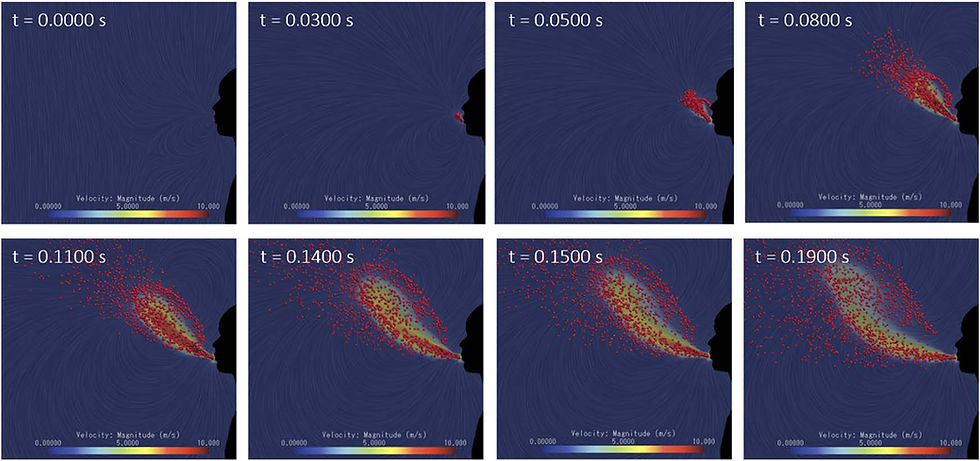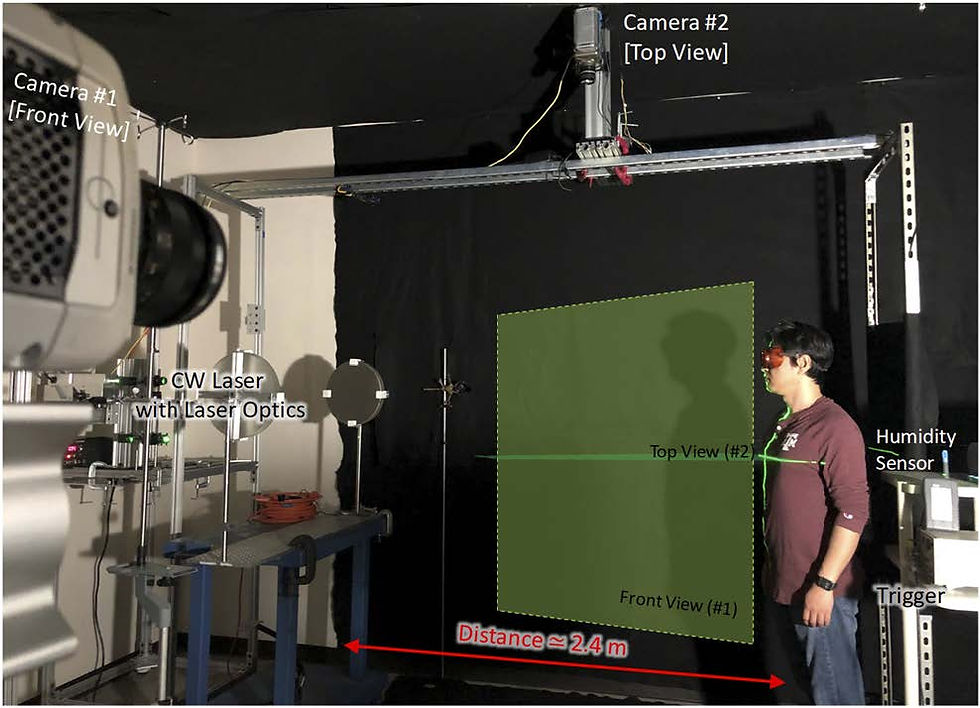Share this
COVID-19 Spread Study Utilizes Quantum Composers Pulse Delay Generator
July 22, 2020

Quantum Composers offers a full series of digital delay pulse generators that can help to create precision timing and synchronization of systems. Many of these units are instrumental in acquiring imaging or laser triggering in the nanosecond or picosecond range. This can be critical for research that needs to capture a series of moments in time with advanced start stop cycles and exact spacing of the image capture.
In a recent study by Texas A&M University, a Quantum Composers Pulse Delay Generator was used to help photograph and map nasal spray patterns during an active sneeze. Tracking the exact trajectory of droplets through use of high speed imaging can create maps of the possible spread patterns and transmission areas. This information then allows the CDC and other health agencies to better inform the public as to how to best prevent the spread of the virus.
The Texas A&M Study Details

The novel coronavirus disease (COVID-19) spread pattern continues to show that geographical barriers alone cannot contain a virus. Asymptomatic carriers play a critical role in the nature of this virus quickly escalating into a global pandemic. Asymptomatic carriers may transmit the virus unintentionally through sporadic sneezing. A novel Computational Fluid Dynamics (CFD) approach has been proposed with a realistic modeling of a human sneeze achieved by the combination of state-of-the-art experimental and numerical methods. This modeling approach may be suitable for future engineering analyses aimed at reshaping public spaces and common areas, with the main objective to accurately predict the spread of aerosol and droplets that may contain pathogens. This study shows that the biomechanics of a human sneeze, including complex muscle contractions and relaxations, can be accurately modeled by the angular head motion and the dynamic pressure response during sneezing. These have been considered as the human factors and were implemented in the CFD simulation by imposing a momentum source term to the coupled Eulerian–Lagrangian momentum equations. The momentum source was modeled by the measured dynamic pressure response in conjunction with the angular head motion. This approach eliminated the need to create an ad hoc set of inlet boundary conditions. With this proposed technique, it is easier to add multiple fixed and/or moving sources of sneezes in complex computational domains. Additionally, extensive sensitivity analyses based on different environmental conditions were performed, and their impact was described in terms of potential virus spread.
Share this
- photonics (19)
- Lasers (12)
- DPSS Lasers (10)
- pulse delay generator (8)
- pulse generator (8)
- LIDAR (4)
- Lasers and Optics (4)
- Technology (4)
- Laboratory Science (3)
- Nd:YAG Lasers (3)
- PIV (3)
- Science (3)
- Spectroscopy (3)
- custom laser systems (3)
- Aerospace studies (2)
- Commercial Lasers (2)
- LIBS (2)
- Laser Induced Breakdown Spectroscopy (2)
- Laser Research (2)
- Laser Science (2)
- Particle Image Velocimetry (2)
- Pulsed Lasers (2)
- custom lasers (2)
- laser ablation (2)
- laser system (2)
- Biotech (1)
- COVID (1)
- Cancer (1)
- Cancer Diagnostics (1)
- Cancer Research (1)
- Current Generators (1)
- Dentistry (1)
- Emerald Pulse Generator (1)
- Flame Kernel (1)
- High Current Pulse Generator (1)
- Ignition and Combustion (1)
- Ignition flame kernel (1)
- Laser Dentistry (1)
- Laser Manufacturing (1)
- Laser Soldering (1)
- Laser Tooth (1)
- Laser aerospace (1)
- Laser photonics (1)
- MDA (1)
- Mass Spectroscopy (1)
- Micro Soldering (1)
- PIV Laser (1)
- Physics (1)
- Research (1)
- Surface mounted technology (1)
- ablation (1)
- artemis nasa (1)
- blue lasers (1)
- delay generator (1)
- er marketing (1)
- laser attenuator (1)
- laser modules (1)
- laser quality (1)
- laser sales and marketing (1)
- laser synchronizer (1)
- lasers for botanical safety (1)
- lasers for cannabis (1)
- lasers purity (1)
- lasers space (1)
- lunar mission 2021 (1)
- lunar missions (1)
- nasa lasers (1)
- nasa payload (1)
- oem lasers (1)
- photonics sales and marketing (1)
- system synchronizer (1)
- February 2024 (1)
- October 2023 (1)
- December 2022 (1)
- November 2022 (2)
- July 2022 (1)
- May 2022 (1)
- March 2022 (1)
- January 2022 (1)
- December 2021 (2)
- November 2021 (2)
- September 2021 (1)
- August 2021 (1)
- July 2021 (2)
- June 2021 (1)
- May 2021 (2)
- April 2021 (1)
- March 2021 (3)
- February 2021 (1)
- January 2021 (2)
- December 2020 (1)
- November 2020 (2)
- October 2020 (2)
- September 2020 (4)
- August 2020 (3)
- July 2020 (3)
- June 2020 (4)
- May 2020 (2)
- April 2020 (6)
- March 2020 (3)
- February 2020 (3)
- December 2019 (2)
- November 2019 (3)
- October 2019 (2)
- September 2019 (1)
- August 2019 (2)
- May 2019 (1)
- April 2019 (1)
- February 2019 (1)
- October 2018 (2)
- September 2018 (2)
- August 2018 (2)
- July 2018 (1)
- June 2018 (1)
- April 2018 (1)
- March 2018 (1)
- February 2018 (1)
- January 2018 (1)
- December 2017 (2)
- September 2017 (3)
- July 2017 (2)
- June 2017 (2)
- March 2017 (4)
- January 2017 (2)
- November 2016 (2)
- September 2016 (2)
- August 2016 (1)
- May 2016 (1)
- April 2016 (1)
- March 2016 (2)
- December 2015 (2)
- October 2015 (2)
- September 2015 (1)
